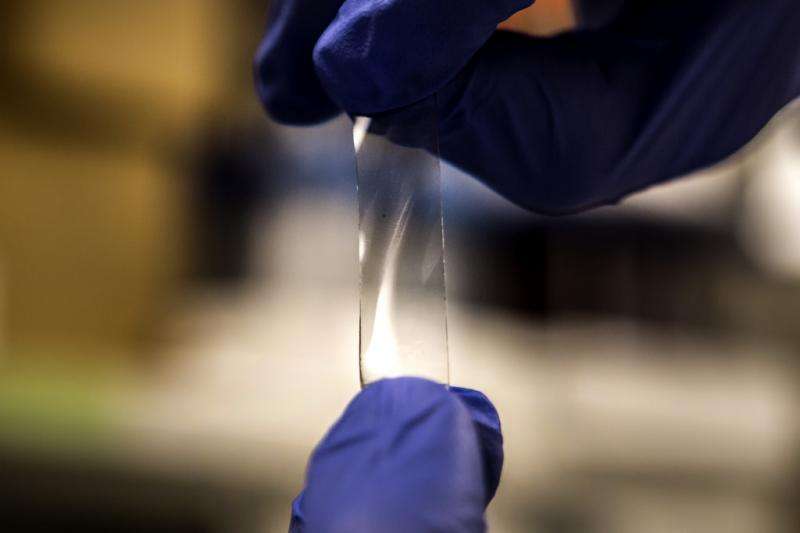Flexible film may lead to phone-sized cancer detector

A thin, stretchable film that coils light waves like a Slinky could one day lead to more precise, less expensive monitoring for cancer survivors.
The University of Michigan chemical engineers who developed the film say it could help patients get better follow-up treatment with less disruption to their everyday lives.
The film provides a simpler, more cost-effective way to produce circularly polarized light, an essential ingredient in the process that could eventually provide an early warning of cancer recurrence. The film is detailed in a paper published online in Nature Materials.
"More frequent monitoring could enable doctors to catch cancer recurrence earlier, to more effectively monitor the effectiveness of medications and to give patients better peace of mind. This new film may help make that happen," said Nicholas Kotov, the Joseph B. and Florence V. Cejka Professor of Engineering.
Circular polarization is similar to the linear version that's common in things like polarized sunglasses. But instead of polarizing light in a two-dimensional wave, circular polarization coils it into a three-dimensional helix shape that can spin in either a clockwise or counterclockwise direction.
Circular polarization is invisible to the naked eye, and it's rare in nature. That makes it useful in an up-and-coming cancer detection process that looks to be able to spot telltale signs of the disease in blood. Currently in the research stage, the process requires large, expensive machines to generate the circularly polarized light. Kotov believes the new film could provide a simpler, less expensive way to induce polarization.
The detection process identifies biomarkers—bits of protein and snippets of DNA—that are present in the blood from the earliest stages of cancer recurrence. It starts with synthetic biological particles that are made to be attractive to these biomarkers. The particles are first coated with a reflective layer that responds to circularly polarized light, then added to a small blood sample from the patient. The reflective particles bind to the natural biomarkers, and clinicians can see this when they examine the sample under circularly polarized light.
Kotov envisions that the film could be used to make a portable smartphone-sized device that could quickly analyze blood samples. The devices could be used by doctors, or potentially even at home.
"This film is light, flexible and easy to manufacture," he said. "It creates many new possible applications for circularly polarized light, of which cancer detection is just one."
Another key advantage is the film's stretchability. Light stretching causes precise, instantaneous oscillations in the polarization of the light that's passed through it. This can change the intensity of the polarization, alter its angle or reverse the direction of its spin. It's a feature that could enable doctors to change the properties of light, like focusing a telescope, to zero in on a wider variety of particles.
To make the film, the research team started with a rectangle of PDMS, the flexible plastic used for soft contact lenses. They twisted one end of the plastic 360 degrees and clamped both ends down. They then applied five layers of reflective gold nanoparticles—enough particles to induce reflectivity, but not enough to block light from passing through. They used alternating layers of clear polyurethane to stick the particles to the plastic.
"We used gold nanoparticles for two reasons," said Yoonseob Kim, a graduate student research assistant in chemical engineering. "First, they're very good at polarizing the kind of visible light that we were working with in this experiment. In addition, they're very good at self-organizing into the S-shaped chains that we needed to induce circular polarization."
Finally, they untwisted the plastic. The untwisting motion caused the nanoparticle coating to buckle, forming S-shaped particle chains that cause circular polarization in light that's passed through the plastic. The plastic can be stretched and released tens of thousands of times, altering the degree of polarization when it's stretched and returning to normal when it's released over and over again.
A commercially available device is likely several years away. Kotov also envisions the use of circularly polarized light for data transmission and even devices that can bend light around objects, making them partially invisible. U-M is pursuing patent protection for the technology.
More information: Yoonseob Kim et al. Reconfigurable chiroptical nanocomposites with chirality transfer from the macro- to the nanoscale, Nature Materials (2016). DOI: 10.1038/nmat4525
Journal information: Nature Materials
Provided by University of Michigan




















